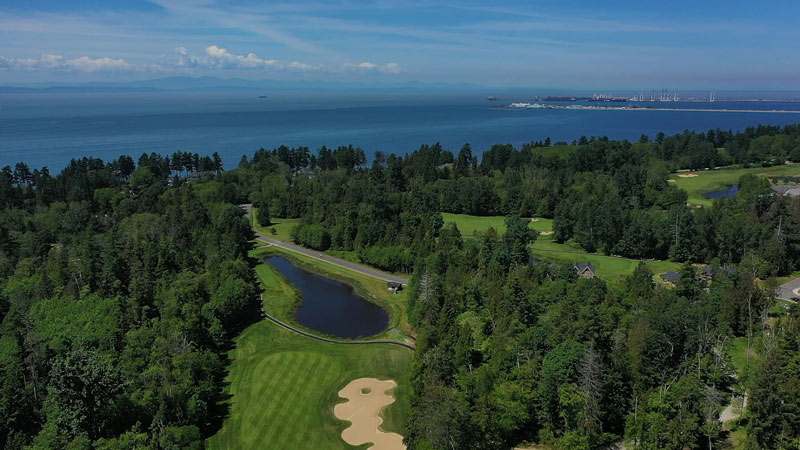
A place apart: Point Roberts, Wash., isn’t an island but is separate from the U.S. mainland and bordered by the Pacific Ocean on three sides. Bald Eagle Golf Club, the 18-hole course in the town, opened in 2001. Photo courtesy of Bald Eagle Golf Club
In some regards, Rick Hoole is living out a golf course superintendent’s wildest dream.
He doesn’t have to rise before the sun. He doesn’t, for once, struggle to staff and schedule a maintenance crew. And when he carries out his duties maintaining Bald Eagle Golf Club at Point Roberts in Point Roberts, Wash., he can do so without any golfers getting in his way or casting a disapproving gaze.
“We were talking about that the other day,” says Hoole, a 15-year GCSAA member. “When it does get back to normal, we’re going to hate it. We’ve had the golf course to ourselves. We don’t have to wait for somebody to tee off ...”
Hoole’s voice trails off.
“No,” he says. “I really do miss it. Then again, you get used to it.”
As the world at large grapples with the variety of tragedies and inconveniences born of the coronavirus pandemic, few areas have been so profoundly affected and, yet, strangely untouched as Point Roberts, a geographic anomaly created by the 1846 Oregon Treaty, which ended a dispute between the United States and the United Kingdom over the Oregon boundary. The resulting border — the 49th parallel — sliced across the tip of the Tsawwassen Peninsula just south of the greater Vancouver, British Columbia, area. The tiny bit of land, about 4.7 square miles jutting out into the Strait of Georgia, is Point Roberts — “Point Bob” to locals — home to about 1,300 year-round residents.
It’s the kind of place that celebrates Canada’s Independence Day on July 1, then does it all again three days later, and its inhabitants usually pay little mind to the invisible but very real line that demarcates U.S. soil from Canadian. Usually.
When the border was shut down in late March 2020, it effectively slammed the gate on tiny Point Roberts. It also did a number on the town’s golf course, whose patrons are primarily Canadian.
“We figured it would be a month-long kind of thing,” says Kyle German, Bald Eagle Golf Club’s general manager and head golf pro. “At the time, it didn’t seem like it would be a huge issue. It seemed like the lockdown and border closing were pretty proactive at the time.”
He laughs.
“We thought it would be taken care of quickly,” German says. “We had every intention of being open for the summer.”
But weeks turned to months.
German, a dual citizen who lives on the Canadian side, hasn’t laid eyes on the golf course since March. About the only eyes that have belong to Hoole, the only staff member left on the maintenance department payroll.
Reached by phone, Hoole is asked whether he can spare a minute to talk.
He chuckles.
“I can be busy at any time,” he says. “Now’s as good a time as any.”
‘The day was just not long enough’
It wasn’t always so easy. Back in spring 2020, during the earlier days of the lockdown, Hoole was outworking the sun, single-handedly maintaining just under 200 acres of fertile, Pacific Northwest real estate that runs right along that imaginary U.S.-Canada line. (Bald Eagle’s fifth hole runs parallel and immediately adjacent to the 49th parallel; “Slice one on No. 5,” German says, “and you’re in Canada.”)
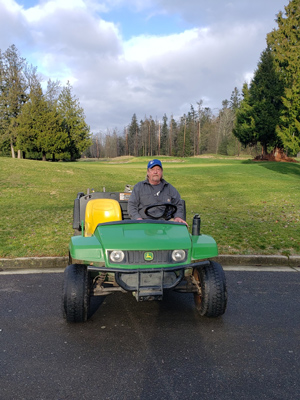
“I was stressed out,” says Hoole (right), a native of Ontario, Canada. “Thankfully, we got into an early order program last year, in the fall, so we had all the chemicals and everything we needed to seed and keep diseases away. We were able to verticut, mow ... but doing it by myself, the day was just not long enough.”
When it became obvious the lockdown was going to last, Hoole shifted from trying to make the course playable to simply keeping it salvageable. He opted to mow greens at Bald Eagle GC — which is normally open year-round and maintained by a staff that peaks around eight to 12 members in the busy summer season — at winter height. The rest of the course’s turfgrass is mowed at 2 inches.
“Weeds are always a problem on the fairways,” Hoole says. “We had to let them dry out in the summer. We buy our water from Canada, and I didn’t want to have to buy any water. I didn’t fertilize, because I didn’t want to promote growth. There’s no way I would have been able to keep up. I was talking to my chemical guy, saying my biggest problem now with my greens is moss. He said, ‘Moss doesn’t like traffic. You gotta get golfers out there.’ How am I supposed to get golfers out there?”
Bald Eagle GC is, in many ways, a playground for Canadians. The classic parkland course bills itself as providing “big-city golf, small-town attitude,” and German estimates 90% of its golfers are Canadian. Hoole speculates there are only 10 or 20 golfers on the Point.
Hoole has thus been the only person making regular loops around the course, where all the flagsticks and tee markers have been put in storage. He estimates the course has seen 100 rounds total since the shutdown, the vast majority played by him. Over the same span in a normal year, the course may have hosted 20,000.
“I play twice a week,” says Hoole, who admits his game has “gotten better” now that he has more time to play. “It helps me see the course from a different perspective. Sometimes guys will come out and want to play golf. I tell them, ‘If you want to play, you have to help me out.’”

The lonely log clubhouse and restaurant — closed since March 2020 — at Bald Eagle Golf Club. Photo courtesy of Rick Hoole
German once called his assistant general manager to check in and learned she was out at the course.
“I asked what she was doing. She said she was pulling weeds in a bunker,” German recalls. “I said, ‘What? Why?’ She said she just had to get out of the house.”
‘There’s not much to do’
It’s one thing to say that Point Roberts is a tiny speck of the U.S. attached to Canada. It’s another to fully understand it. But don’t expect much virtual help to visualize it: Google Street View doesn’t work there. Internet voyeurs can spy all over Tsawwassen, but Street View doesn’t work on the Point Roberts side of the border.
“Not to sugar-coat it too much,” German says, “but there’s not much to do in Point Roberts. There’s no bowling alley, no theater.”
There is a health clinic, but no hospital. There are a few convenience stores — pre-pandemic, Canadians could take advantage of currency-conversion idiosyncrasies to buy cheap(er) gas — a cafe and a grocery store. The lone school only teaches students in kindergarten through third grade, so older kids bus across the border to Tsawwassen, a 10-minute drive, or to Blaine, Wash., nearly one hour — and two international border crossings — away, each way.
That was before the border closed, however.
Now, Point Roberts residents can leave via the land route only for reasons deemed “essential” and are not allowed to stop in Canada on their way to the mainland U.S. The only other way to reach the mainland is by private boat, a twice-weekly flight to Bellingham, Wash., or aboard the weekly ferry that goes to Bellingham.
Perhaps even the insidious coronavirus has decided it’s not worth the hassle — news reports have declared Point Roberts the safest place in America, as not a single case of COVID-19 has been reported there.
But other dangers, perhaps, lurk in this geopolitical quirk of a region that is isolated from both the country that claims it and the one that abuts it.
“It’s been tough,” German says. “The people who live there, for coming up on a year now pretty quick, have had a rough, rough go. They’re locked into that community. My heart goes out to them. It’s a tough spot, and there’s no really easy solution. I talked to Tracy, my assistant GM, and asked what it’s really like. She says it’s spooky. It’s eerie. She says there’s traffic. I said, ‘Traffic? What do you mean?’ She says people are getting in their cars and just driving around, trying to get some sunshine, just ... driving around the Point. That’s not healthy. There has to be some mental health concern for the whole area.”
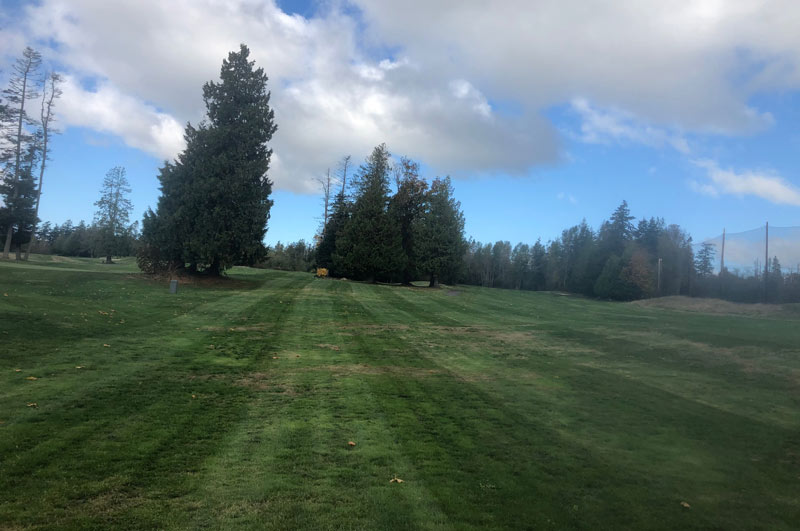
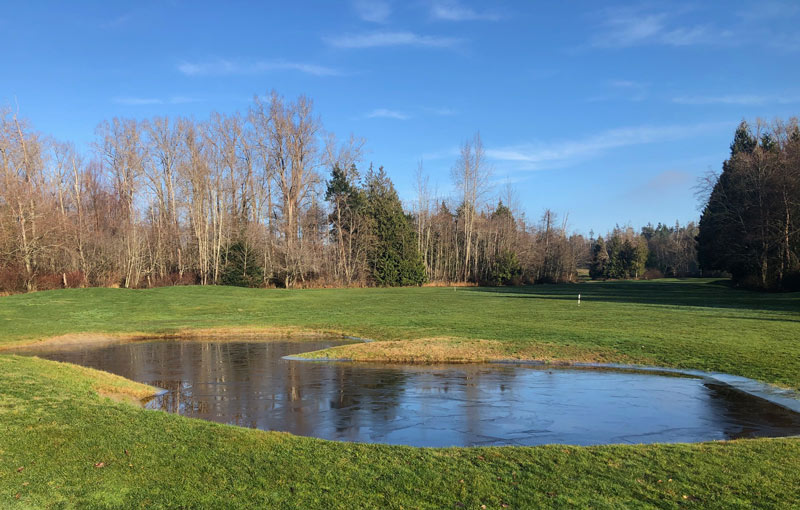
Land left idle: Shots of the deserted golf course captured by superintendent Rick Hoole.
Tracy Evans, German’s assistant GM, is also a real estate agent in town. She reports another strange byproduct of all that’s going on.
“We have seen a lot of play on our website, a lot of contact for info requests,” German says. “Oddly enough, maybe just because of the title of ‘Safest place in America,’ real estate sales have been really strong in Point Roberts. Real estate normally isn’t very strong in Point Roberts, but now sales are really strong, a lot of it sight unseen. People from California, Nevada, the Midwest, the South … people are buying property sight unseen. (Tracy) says she’s seen an absolute uptick in interest. She says she doesn’t know why her phone is ringing, but she’s glad it is.”
‘I miss my crew’
Hoole says he has only left the Bald Eagle GC grounds a few times in the past year, mostly for essential trips to retrieve parts or equipment for the course.
“It’s a real treat,” he says, “when an essential worker comes back with a Big Mac.”
Wildlife was common on the golf course before, but even more so now. Hoole says deer are abundant, unashamedly rutting on his greens. Coyotes “think they own the place.”
Before he came to Bald Eagle GC in 1999, Hoole worked as a logger in Haida Gwaii, also known as the Queen Charlotte Islands, off the northern Pacific coast of Canada.
“So I’m used to the isolation,” he says.
Still ...
“I miss my crew,” he says. “I miss the golfers. I miss talking to people.”
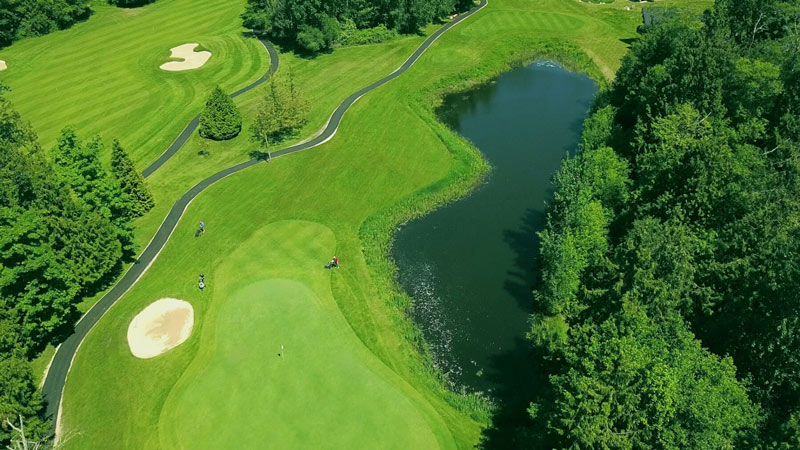
The 12th hole at Bald Eagle Golf Club during brighter days. The facility is a classic parkland course that features bentgrass greens. Photo courtesy of Bald Eagle Golf Club
A dual citizen, Hoole says he never considered abandoning his post, even if it once abandoned him.
German ran the place — back when it was Point Roberts Golf & Country Club — between 2005 and 2012, but the previous owner had let it slide, and it fell into disrepair and eventually closed.
Hoole found himself out of work. He started a landscaping business and did odd jobs.
A new group came in and bought Bald Eagle GC in 2017 and hired Wayne Carleton, the original architect, to reinvigorate it. Over the next year, the new owners poured millions into the renovation, which featured 17 new greens and paved cart paths. And Hoole returned.
Now, Hoole guesses the course is maybe month away from acceptable playability once the border is thrown open, depending, of course, on which season that might occur.
Meanwhile, he’ll continue his labor of love.
“I was working sunup to sundown, and I hated it, but it had to be done,” he says. “I love the job. That’s the drive. I’ve seen it go down. I don’t ever want to see that again. I’m turning 65 soon, so retirement isn’t that far away. This is my baby.”
Andrew Hartsock is GCM’s managing editor.